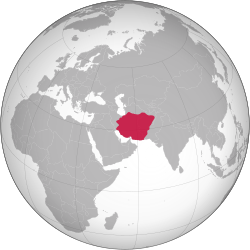Hotaki dynasty
Hotaki dynasty | |||||||||
|---|---|---|---|---|---|---|---|---|---|
| 1709–1738 | |||||||||
|
Flag | |||||||||
 Hotak Empire at its peak (1722–1729) | |||||||||
| Capital | Kandahar Isfahan | ||||||||
| Common languages | Pashto and Persian (poetry)[a] | ||||||||
| Religion | Sunni Islam | ||||||||
| Government | Absolute monarchy | ||||||||
| Amir | |||||||||
• 1709–1715 | Mirwais Hotak | ||||||||
• 1715–1717 | Abdul Aziz Hotak | ||||||||
• 1717–1725 | Mahmud Hotak | ||||||||
• 1725–1730 | Ashraf Hotak | ||||||||
• 1725–1738 | Hussain Hotak | ||||||||
| History | |||||||||
• Revolt by Mirwais Hotak | 1709 | ||||||||
• Disestablished | 1738 | ||||||||
| |||||||||
The Hotaki dynasty was a dynasty founded by Pashtun[1] Ghiji tribe. In 1709 by Mirwais Hotak at Kandahar, Afghanistan. They revolted and made their land independent from foreign ruler, but later they invaded Persia and defeated the great Iranian Empire of the Shi'a Safavids.
Mahmud Hotaki, son of Mirwais, ruled Persia until he died in 1725 and then his cousin Ashraf ruled until 1729 when Nader Shah Afshar defeated him.[2]
The last king was Hussain Hotaki in Kandahar until he was defeated by Nader Shah in 1738.[3]
References[change | change source]
- ↑ Hanifi, M. Jamil (2001). "ḠILZĪ". Encyclopaedia Iranica Online. Vol. X, Fasc. 6, pp. 670–672, "(...) one of three major Pashtun/Paxtun tribal confederations in Afghanistan."
- ↑ Malleson, George Bruce (1999). History of Afghanistan, from the Earliest Period to the Outbreak of the War of 1878. London: Elibron.com. p. 227.
- ↑ "AN OUTLINE OF THE HISTORY OF PERSIA DURING THE LAST TWO CENTURIES (A.D. 1722-1922)". Edward Granville Browne. London: Packard Humanities Institute. p. 33.
Notes
- ↑ Shah Hussain Hotak wrote poetry in Pashto and Persian.

